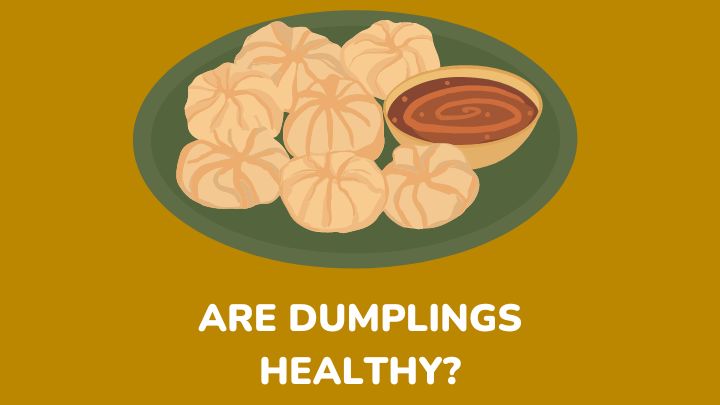Dumplings are originally China’s fast food. However, diverse countries and cultures have created their recipes, and it has become a broader class of food. They are small parcels of dough and fillings that can be highly indulging. So, before you grab some more, you should know if eating a lot of dumplings is healthy.
Dumplings can be cooked in several ways and the way you make them determines the nutritional benefits. Also, the ingredients in yours determine if you are doing your health a favor or not.
Ahead, this article discusses the implications of eating dumplings as part of your diet. You will also get to learn how you can make your dumplings healthy.
What are dumplings made of?
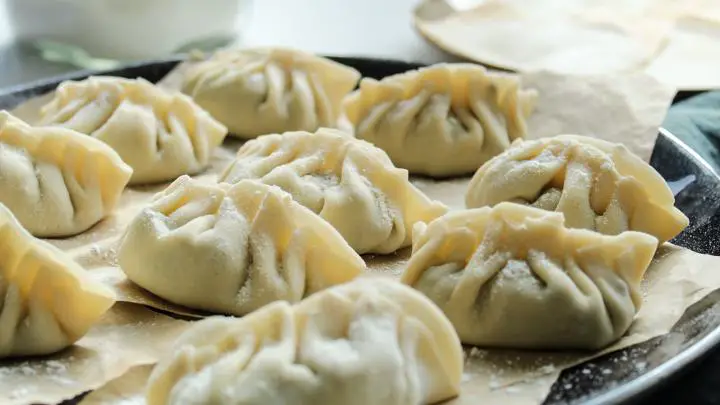
Dumplings are small parcels of dough with fillings. The dough is made with flour, water, and eggs (optional). The fillings are usually a combination of meats, vegetables, cheese, seafood, and sometimes fruits. The combination of ingredients gives them their savory taste.
Dumplings began in Asian cuisine but have now spread into South America, Europe, and places in Africa.
Each region has its unique recipe and creates various flavors that contribute to this wide class of food. Also, each region has a unique name for their dumplings.
For instance, the Chinese have wontons and jiaozi, the Japanese have gyoza and shumai, Koreans have mandu, some parts of Europe have pierogi and knödel, and South Americans have empanadas and arepas.
Generally, all dumplings consist of a dough and fillings which vary with people and their preferences. There are different ways to cook dumplings. You can boil, steam, pan-fry, deep-fry, and bake yours. The method of cooking you use determines the taste and texture of your dumplings.
Dumplings are not eaten alone, at least not commonly. They are usually paired with a dipping sauce to complement their flavors.
Ingredients in dumplings
Before the health benefits, you should know what makes up these delicious small parcels. The common ingredients are:
Dough
The dough is the outer covering of dumplings that gives them structure. It is typically made with wheat flour, water, and eggs.
However, you can modify your ingredients to suit your preferences. You can replace wheat flour with vegan flour like rice flour if you are gluten intolerant.
Eggs are optional ingredients, but they are usually added for moisture and to increase elasticity. You can make your dough at home or buy dumplings wrappers from the store.
Meat
Almost any type of meat is perfect for dumplings. Different cuisines, chefs, and people use different meats to suit your preferred flavors. Pork is the most common meat used but beef, chicken, lamb, fish, and seafood can work as well.
Vegetables
Vegetables add a richness of vitamins and minerals to dumplings. You can use veggies such as mushrooms, scallions, spinach, carrots, and cabbage for your fillings.
While you can use just one, a combination of two or more veggies will make your dumplings tastier and more nutritious.
The seasonings
Seasonings include the herbs and spices you add to the fillings. Garlic, ginger, soy sauce, cilantro, basil, mint, sesame oil, and dill are common herbs and spices used in dumplings. They add a savory taste and impart depth of flavor to the fillings.
Dipping sauce
Dumplings are usually served with a dipping sauce to complement the flavors. The most common sauces used are soy sauce, vinegar, and chili oil.
The most common types of dumplings
Wontons
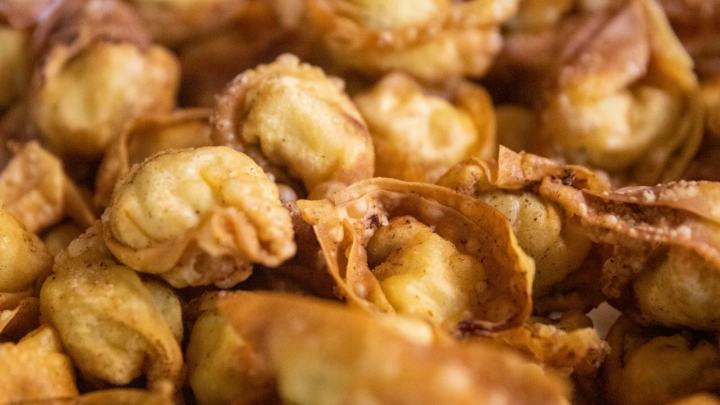
Wontons are the most popular Asian dumplings, and they are eaten in other regions besides Asia. They are small parcels of dough filled with minced meat, shrimp, or a combination of both. Wontons are usually steamed and served in a noodle dish or deep-fried to give them a crispy texture.
One fried wonton provides 30 calories, 1 gram of fat, 4 grams of carbs, and 1 gram of protein. You don’t have much to worry about with wontons because they provide only a small number of calories.
Har gow

Har gow are shrimp rice dumplings. It is an exciting meal of one piece of shrimp wrapped in a clear rice paper shell.
It has a savory taste and an exciting texture that pops into your mouth at every bite. Har gow is best dipped in soy sauce or mustard to complement its flavor.
One piece of har gow provides about 35 calories, 6 grams of carbs, 1.5 grams of fat, and 1 gram of protein.
Mandu
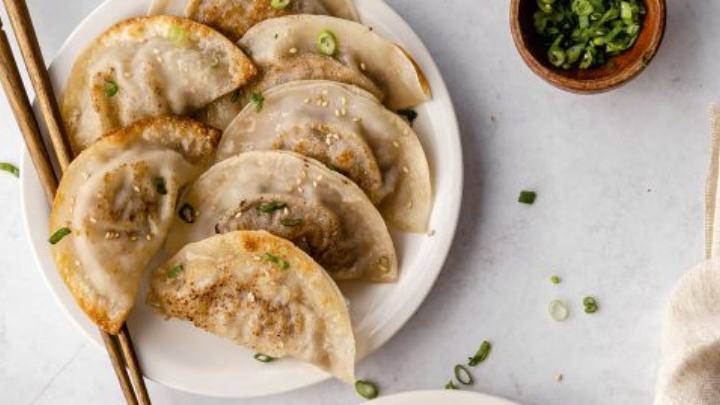
Mandu is a traditional Korean dumpling that is usually steamed but can be fried too. It is a dough filled with minced meat, cabbage, chives, and garlic. They come in rectangular or crescent shapes.
You can steam, boil, or pan-fry mandu, depending on the taste and texture you want to achieve.
Traditional mandu is usually bigger than a regular dumpling and is much softer with a thick and chewy bite. One piece of mandu contains 60 to 70 calories, 5 grams of fat, 5 grams of carbs, and 4 grams of protein.
Shumai
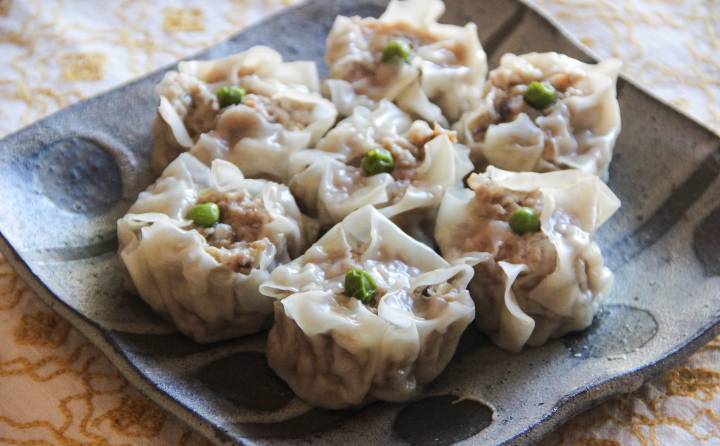
Shumai is a dough filled with shrimp, pork, and mushrooms. It is a low-calorie dumpling packed with protein which makes it highly filling. One piece of shumai dumpling provides 57 calories, 4 grams of carbs, 3 grams of fat, and 4 grams of protein.
Empanadas

Empanadas are delicious dumplings. The dough is filled with meat, cheese, veggies, herbs and spices. They are a popular dish throughout Latin America and some other regions. These dumplings have the highest number of calories and carbs.
One beef empanada provides 263 calories, 28 grams of carbs, 16 grams of fat, and 10 grams of protein.
Are dumplings healthy?
Dumplings can be healthy if you eat only a few pieces and keep your calorie and carb consumption within your recommended daily allowance (RDA).
However, dumplings are highly indulgent, and it can be very tempting to eat a lot and exceed your RDA of nutrients.
Moreover, it is high in sodium and saturated fats which can be unhealthy for you. How you cook dumplings and the ingredients they are made with determine how healthy they are.
All dumplings contain calories, fat, and carbs but steamed or boiled dumplings contain fewer calories, carbs, and fats than the fried variety. Also, you should not overeat dumplings. The more you eat, the more calories, carbs, and fats you consume.
In essence, you determine how healthy eating dumplings is for you.
Are steamed dumplings healthy?
Steaming dumplings preserves their nutrients better than frying and baking.
Steamed dumplings have lower fat content and moderate amounts of carbs and proteins. This method of cooking does not require extra fats to cook so the dumplings are usually low in saturated fat.
Are dumplings good for weight gain or loss?
Dumplings can support your weight loss plan if you practice portion control and modify your calorie intake.
The fillings in your dumplings, the size, and the cooking method determine the calorie content. Create weight loss-friendly options with lean protein fillings like chicken or seafood. Add a lot of vegetables like mushrooms, scallions, and cabbage to make them healthier.
Are dumplings gluten-free?
Traditional dumplings recipe uses wheat flour for the wrappers and the fillings usually contain soy sauce, both of which contain gluten.
If you are eating gluten-free, make your dumplings at home so you can make gluten-free wrappers and modify your recipe to suit your diet.
Are dumplings vegan?
Dumplings may be vegan or not, depending on the ingredients in the dough and the fillings. Eggs, butter, cheese, and meats are not vegan. You can make yours vegan if you leave out these ingredients in your recipe.
Side effects of eating dumplings
- Excessive consumption of dumplings can cause digestive issues like bloating
- Dumplings are high in sodium. Overeating them can raise blood pressure, lead to hypertension, and increase the risk of cardiovascular diseases
- Another associated risk of overeating dumplings is obesity and type 2 diabetes
- Dumplings are high in calories. Excessive consumption of these fast foods could lead to weight gain
- Store-bought dumplings may contain additives which can be cancerous
How to make dumplings healthy
Boiling or steaming is the way to go
Boiling or steaming dumplings is healthier than frying them. Frying adds 2 to 3 grams of extra fat to one dumpling. Fried dumplings are irresistible and may be more enjoyable because of their crisp texture. However, your
Pick healthy meats
Use lean meat cuts instead of fatty cuts for your fillings. You may not get this assurance if you are eating out, but you can make sure of this when you make dumplings at home. When you eat out, remember to practice portion control.
Stuff some more greens
Vegetables are rich in vitamins and minerals. They also add an appealing crunch and color to your dumplings.
Make your sauce
Replace the store-bought sauce with a homemade low-sodium option like sweet chili sauce or a mixture of black vinegar & sesame oil. These sauces taste just as nice as the high-calorie and high-sodium versions you get from the stores.
Pair with healthy sides
Make your dumpling dish healthy with healthy sides like salads and beans with lots of protein. With these pairings, you won’t have to eat so many dumplings because they are highly filling.
FAQs
How many dumplings is too much?
Dumplings are small and highly indulgent. You should not eat too many dumplings because they are high in carbs and sodium, which are unhealthy for you.
Are dumplings healthy for pregnant women?
Eating dumplings during pregnancy is not very advisable. They may not be well-cooked and may contain fungi, which could cause bleeding if ingested.
Dumplings also contain high amounts of sodium, which can raise blood pressure in pregnant women.
Can a diabetic eat dumplings?
Dumplings are not a very healthy choice for diabetics.
They contain ingredients that are high in carbs, saturated fat, and sodium which are a bad combination for a person trying to keep their sugar levels in check. However, you can make healthy versions at home to suit your dietary needs.
Can you eat raw dumplings?
Eating raw dumplings can be harmful to your health. Raw dumplings contain uncooked flour, eggs, meat, and vegetables. It may be contaminated with bacteria or E. coli, which could make you sick.
Conclusion
Dumplings can be healthy or unhealthy. The nutritional benefits depend on the type of dumplings you eat, how you prepare them, and the quantity you eat.
This delicious delicacy is usually high in sodium and saturated fat and might pack more calories if you fry them. However, you can modify your recipe and make healthier dumplings using the tips above.
Make your fillings with lean meat, add more veggies, and boil the dumplings instead of frying them. Also, choose a low-sodium sauce like sweet chili sauce, chili oil, or a mixture of black vinegar & sesame oil.
More on popular Asian food. Find out if you should be eating as many rice cakes as you have been eating.
Thanks for reading.
